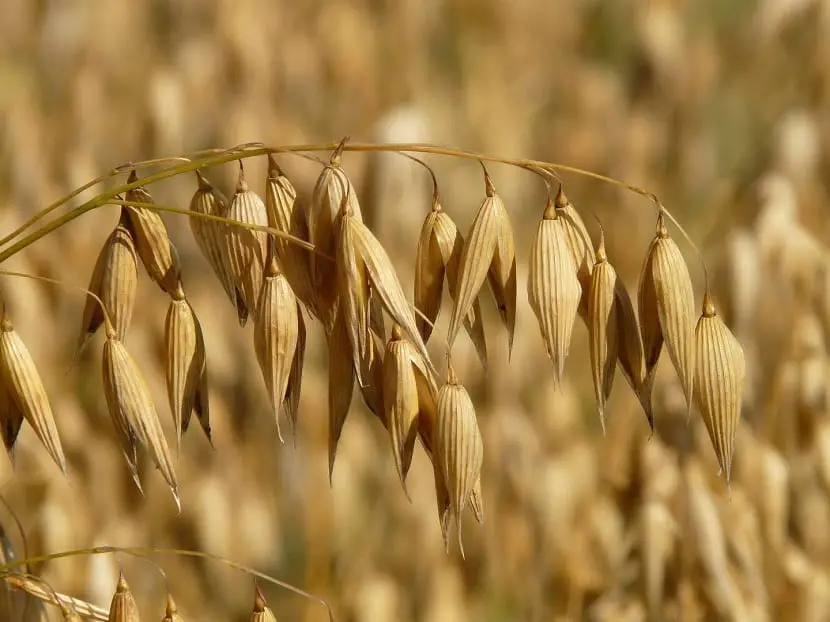

Today we are going to talk about the oats. It is a genus of plants that belongs to the Poaceae family and whose scientific name is Avena sativa. It is used as food and as fodder. Although in earlier times it was not as important as wheat or barley, in Central Asia it was cultivated in good quantities. Oats have been considered a weed for many years. However, today many benefits are known for the body and it is treated as a high quality whole grain. All those people who want to take care of their diet or gain muscle mass eat oatmeal almost daily.
In this article we are going to tell you everything you need to know about growing oats.
Main characteristics of oats


It is an annual herbaceous plant. The most cultivated species of oats is the aforementioned Avena sativa. One of the most differentiating characteristics of this group of grasses is that the first and second flowers of the spikelet have a joint.
It has a fairly large and powerful root system. Unlike other cereals, it has a large number of roots and much deeper. The stems are thicker and more erect which make it resistant to the wind. However, they have little resistance to tipping. The length of the stems is usually between half a meter and up to a meter in height. Some specimens that grow in good conditions have been seen to reach one and a half meters. The stems have internodes that end up forming much thicker knots.
As for its leaves, they are flat and elongated. They have a ligule between the union of the blade and the stem, but without stipules. The edge is serrated. The nerves that the leaves have are all parallel to each other and are quite differentiated. The ligule has an oval shape and a whiter color. On the other hand, the blade is narrower and elongated with a more or less dark green color.
When the flowering season comes, A small cluster of spikelets with two or three flowers emerges that are located on long peduncles. Its fruit is a caryopsis.
Cultivation of oats


Oats are considered a plant that grows and develops in the cold season. The areas where the world’s largest oat crops are located are usually in temperate climates, tending to colder. And is that this plant it has greater resistance to cold than barley or wheat. However, it is more sensitive to high temperatures. If there is a rise in temperatures in the flowering season or during the formation of your grain, it will be seriously affected. Therefore, to prevent this increase in temperatures typical of more tropical climates, it is preferred to sow in colder climates.
It is not demanding in terms of the type of soil in which it is planted, but yes it is demanding with the irrigation water. This is due to the fact that it has a fairly high coefficient of perspiration and loses a lot of water in the process of photosynthesis. You have to be careful with watering and take into account the wind regime at all times because it is sensitive to humidity. If it has an excess of humidity due to having too much watering or a weather that is too stable that does not help it to perspire, the plant may suffer a lot and deteriorate.
The water needs of oats are higher than those of other winter cereals. For this reason, to also save irrigation water, they are sown in temperate climates, tending to cooler ones where rainfall is higher and there are more drafts that facilitate their transpiration. This means that oats call for spring stages with abundant rains. If this happens, you are sure to have a great crop of oats. You have to be careful with excess humidity, but also with drought. Especially at the time when the grain is forming, drought must be avoided at all costs.
Land


It is a fairly rustic plant. It is generally not picky about the type of soil. It can be adapted to almost any terrain, although it has a preference for deep, clay-sandy soils. Soils must retain some moisture, but without stagnating. Oats are adapted to soils with a somewhat more acidic pH between 5 and 7. They are usually sown on land rich in organic matter.
In general, preparation for growing oats is poor. It is usually a fairly poorly maintained crop, both in tillage tasks and in compost. However, if the cultivation of oats is treated with more care, the land is well prepared and fertilized, if to that we add that there is a fairly rainy spring, we can have very high oat productions.
To sow it it is better to wait until the spring season, since at first it is hardly resistant to cold. They are sown from January on dry land until March on irrigated land. In lands that do not have too many nutrients, more is usually planted as an alternative head. Oats in winter are sown before wheat. In lands that do have more fertility, it is more common to see that oats are sown after wheat or barley.
Subscriber


As for the subscriber, It can be done at sowing or during the vegetative growth phase. If the plant is intended for green forage, it is better to intensify the amount of nitrogen that is provided to achieve abundant vegetation. If it is destined for grain, an excess of nitrogen lengthens the vegetative cycle of the plant. This is not at all convenient, as you can risk the grain becoming seized.
I hope that with these tips you can learn more about growing oats and how to optimize it for better performance.
